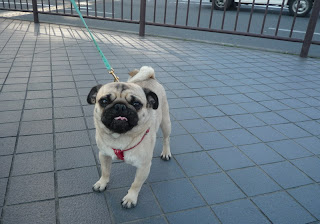Arrival at the monument to the 47 ronin.
After Kira to avenge their Lord Asano, the ronin are passed by a shop in miso, Chikumaya. The owner of the shop was the friend of Ootaka Gengo, a member of ronin, so Chikumaya offered a amazake (sweet sake, made from fermented cooked rice) to ronin.
The store, which is still in business, every year offers all the amazake the day of vengeance, December 14.
The monument behind the shop is now called
Chikuma-miso
Chikuma-miso
The explanation on the history with the 47 ronin
Bridge Eitaibashi
the right of the bridge, there is a small police office (Koban).
Since I do not know where was the monument, I asked a policeman.
is very close from here, turning the street on the right.
The ronin, after a little 'rest went to Sengakuji.
The previous post about Sengakuji:
I met a cute pug.
I have never heard this kind of a dog barking. Still breathing noisily through the nose.
It 'nice, especially his tail.
's arrival at the place where he was born Takizawa Bakin (1767 - 1848), the noted author of Nanso Satomi Hakkenden.
The monument of the place of birth
is figured with the books in 106 volumes
The old post on Nanso Satomi Hakkenden:
http://grandebanzai.blogspot.com/2010/11/nanso-satomi-hakkenden.html Reiganji Way to the temple.
Entry
Here is the tomb of Matsudaira Sadanobu (1759-1829), the politician who has made the reform called "Kansei no kaikaku," or "reform Kansei period "from 1787 to 1793. It was also the daimyo of Shirakawa village, the modern town of Shirakawa in Fukushima.
Since his tomb is here, this neighborhood is called Shirakawa.
The tomb of Matsudaira Sadanobu Since his tomb is here, this neighborhood is called Shirakawa.
A statue of Jizo of 2.5 meters
Other Jizo
I photographed the monument. It looks like a tomb of a woman, because you see a girl's name right, not the name when she was alive, but the name given after his death (a practice common with Buddhism).
On the left you see the data vertically. He understands the day, December 24. But the character of the year is ruined. You see 子, or part of another ideogram. The first few years of the period named with the character of 保. Why 元 we noted the first year. While 丙 申 and indicate the year hino-saru. The combinations are sixty. Sixty are combinations of the twelve Chinese zodiac of twelve animals and ten members, always with the concept of Chinese culture.
Last hino-saru was 1956. The Showa era. The penultimate was 1896, in the Meiji era. Following 1836, 1776, 1716, 1656, 1596 etc..
While looking for was that the character 保, the only possibility is 享 保 (kyoohoo) beginning from 1716. Why is the year 1716, Hino-saru.
I found the year. E 'in 1716. The character is ruined 享. You see only the lower part of the ideogram 子.
Well, the day was recorded December 24, 1716, probably the day of death of this person.
While looking for was that the character 保, the only possibility is 享 保 (kyoohoo) beginning from 1716. Why is the year 1716, Hino-saru.
I found the year. E 'in 1716. The character is ruined 享. You see only the lower part of the ideogram 子.
Well, the day was recorded December 24, 1716, probably the day of death of this person.
Graves collected.
now are too old, so they are anonymous
now are too old, so they are anonymous
walk toward the subway station, Kiyosumi Shirakawa.
There is a park, Kiyosumi Teien.
I found the cats.
Li photographer as always.
Shishiodoshi
Sidewalk
Pond
Ducks
A large bird
returns to Monzennakacho.
The view from a bridge.
going to the streets, many are local classics.
I edited a photo of the road with color to sepia. It looks like the picture of the fifties.
Lana
























0 comments:
Post a Comment